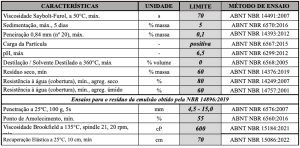Slow-setting cationic asphalt emulsion modified by elastomeric polymers, which has a minimum asphalt binder of 60% and maximum Saybolt-Furol viscosity at 50°C of 70 seconds, indicating low consistency. Neither the demulsibility test nor the cement or silica filler mix test is performed to characterize it. The emulsion residue, among other characteristics, must have a minimum softening point of 55°C and elastic recovery at 25°C of at least 70%.
Emulsão Asfáltica
RL-1C-E
Elastomeric Polymer-Modified Emulsions

Technical Specifications

Description


Description

CBAA FLEX RL-1C-E is a special cationic asphaltic emulsion, with slow rupture, modified by elastomeric polymers, which presents an excellent behavior and durability against the effects of the weather and the demands of heavy traffic.
Its formulation with specific emulsifiers, with slow rupture characteristics, provides, in addition to the advantages of conventional asphalt emulsions, the following benefits:
- High power of internal cohesion;
- Satisfactory adhesion with different types of aggregates, acid or alkaline in nature;
- Flexibility;
- Resistance to aging and exudation in the face of large temperature variations;
- Elastic properties when compared to the plastic behavior of binders.

Uses


Uses

CBAA FLEX RL-1C-E is specifically used in paving services of the cold pre-mixed type (PMF’s) of semi-dense and dense granulometric graduation, cold asphalt sand (AAF), asphaltic mud (LA), pothole fillers, connection paint and sealing of cracks.

Application


Application

CBAA FLEX RL-1C-E is used in mixtures of the Cold Premixed type (PMF’s) and can be applied on the track immediately after machining or stored with canvas protection for a period of up to 2 days.
Asphalt mixtures of the Asphalt Mud type (LA) are applied with mobile plants, directly on the pavement to be superficially treated. Asphalt slurries using CBAA FLEX RL-1C-E require a curing period (in the sun) of approximately 3 hours.
In case of storage for long periods, it is recommended to circulate the product once a week. Avoid successive recirculation and pumping to prevent a decrease in viscosity and rupture due to entrained air. We do not recommend storage for more than 21 days.

Features


Features

CBAA FLEX RL-1C-E is manufactured in accordance with ANP Resolution No. 897, of 11/18/2022 and DNIT 165/2013 – EM:


Presentation


Presentation

CBAA FLEX RC-1C-E it is supplied in bulk, Liquid (tons) in tank cars.

Recommendations


Recommendations

During handling, use PPE (Personal Protective Equipment). In the event of an accident, consult the Safety Data Sheet for Chemical Products (FISPQ – No. CBAA.002).

Employment restriction


Employment restriction

It is not recommended to carry out paving services using the CBAA FLEX RL-1C-E, at temperatures below 10°C.

Handling


Handling

CBAA FLEX RL-1C-E is classified by the UN (3082), as a substance of risk 9 and subclass N.E (liquid substances that present a risk to the environment).
When the product arrives at the work site, collect the sample for the reception/quality tests.
The product must not be heated for use under any circumstances. If, when the product arrives at the site, it is at high temperatures, leave it to rest until it reaches room temperature.
Contact with the cold product does not cause irritation to the skin, causing burning in the eye when hit. Cold product in contact with the skin will be removed with soap and water. Asphalt residue can be removed with vegetable or mineral oil.

Storage


Storage

The product can be kept in deposits (bulk), duly sealed. It is not recommended to store the product for a period longer than 21 days.
CBAA FLEX RL-1C-E is a product with low viscosity characteristic. When at rest for a long period of storage, sedimentation of asphalt globules occurs on the lower surface and emergence of the chemical aqueous phase that composes the emulsion, requiring circulation to homogenize the same for its application or the occurrence of partial rupture of the emulsion state .



